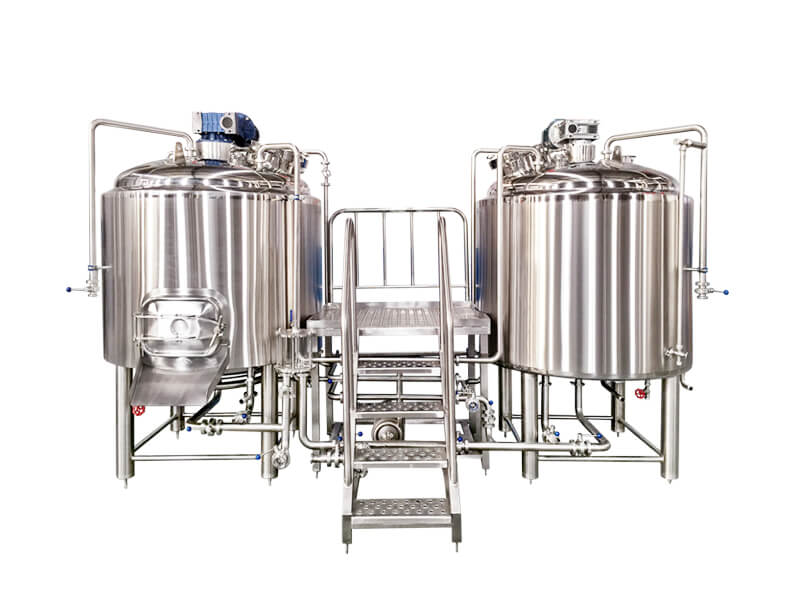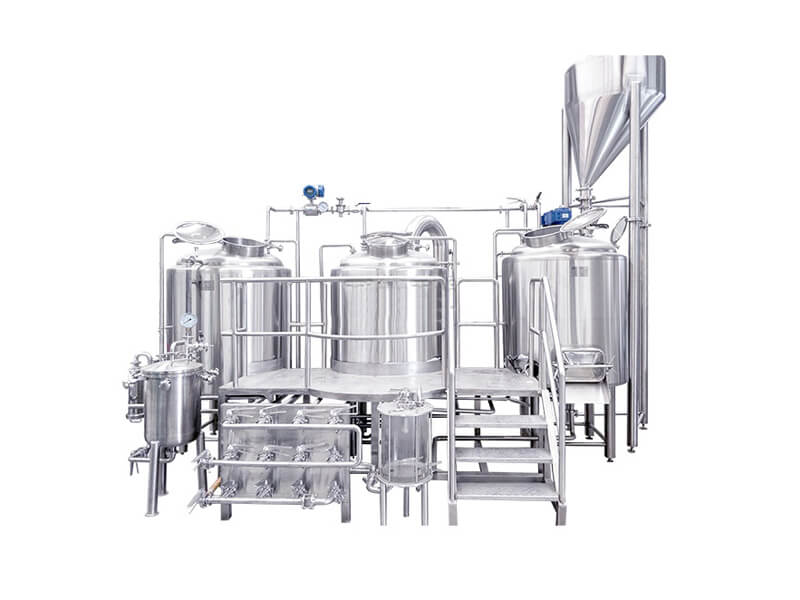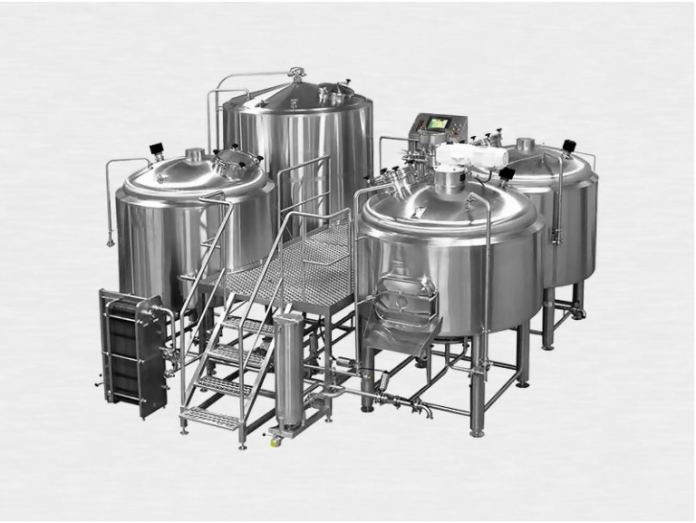Brewhouse System
Equipment composition: Mash tun/lauter tun/wort kettle/whirlpool/hops filter /plate heat exchanger /sanitary pump etc.
Two Vessels Brewhouse
Combination:-- Mash/Lauter Tun + Boil Kettle/Whirlpool Tun
-- Mash/Lauter Tun/Hot Liquor Tank Combi vessel + Boil Kettle/Whirlpool Tun
-- Mash/Lauter Tun + Boil Kettle/Whirlpool + Hot Liquor Tank
Available Capacity:50L-30T , 1BBL-30BBL or Customized
Heating Type:Steam heating ,Electric Heating or Direct-flame Heating
Control mode:Semi-automatic/ Full Automatic

Three Vessels Brewhouse
Combination:-- Mash(kettle) Tun + Lauter Tun + Boil Kettle/Whirlpool Tun
-- Mash/Lauter Tun + Boil Kettle + Whirlpool Tun
Mash /KettleTun: with grist hydrator, racking machine (frequency control)/ spend grain out door
Whirlpool Tun: With special customized tangent whirlpool port
Available Capacity:50L-30T , 1BBL-30BBL or Customized
Heating Type:Steam heating ,Electric Heating or Direct-flame Heating
Control mode:Semi-automatic/ Full Automatic

Four Vessels Brewhouse
Combination:Mash(kettle) Tun + Lauter Tun + Boil Kettle + WhirlpoolMash tun: mixer(frequency control), bottom and shell with jacket
Lauter tun: with bottome spend grain out door and racking device (frequency control)
Kettle tun: bottom and side with jacket
Whirlpool tun: With special customized tangent whirlpool port
Available Capacity:50L-30T , 1BBL-30BBL or Customized
Heating Type:Steam heating ,Electric Heating or Direct-flame Heating
Control mode:Semi-automatic/ Full Automatic

In the process of brewing beer, the mashing is a very important step. The following is introducing the advantages and disadvantages of each mashing system combination.
(1). Two vessels combinations of mashing system
This kind of equipment is now widely used in the industry, mainly make up with mash/Lauter tun, kettle/whirlpool. The function of mash/lauter tun; mashing and filter, Kettle/whirlpool function; boiling and whirlpool. If you configure a hot water tank, the work effective can be increased by 50%.
(2). Three vessels combinations of mashing system(two tanks with three vessels of mashing)
This equipment is generally combined with boiling tank/kettle, Mash/Lauter tun, whirlpool tank. In fact, Its Lauter/whirlpool tank was actually composed of the upper and lower structures.The upper structure is the Lauter tun, and the lower layer is the whirlpool tank. It is commonly seen in beer houses and restaurants.
(3). Three vessels combinations of mashing system(three tanks with three vessels of mashing)
Such equipment is commonly found in small and medium-sized breweries. The equipment is available in a variety of combinations.
(4). Four vessels combinations of mashing system
Such equipment is common in small or medium-sized breweries, and is equipped with hot water tanks in addition to mashing basic equipment, which can greatly improve production efficiency.
Its main advantages are:The mashing apart has a clear division of labor, which significantly reduces the time occupied by the tank and improves production efficiency. The maximum brewing batch of beer can reach five batches per day.
There is no “best” heat source. We make equipment that works with all kinds of heat sources according to our customers’ needs. Each one has its own advantages and disadvantages, as outlined below. In general, gas fired systems are more likely to be optimal for home brewers and small commercial operations. Electric is most likely to be optimal for small commercial systems (2 to 10 bbls), and steam heat is most likely to be optimal for larger systems. You can learn more about the advantages and disadvantages below.
(1). Electric Heat
Advantages
- Highest efficiency: 100% of heat generated is transferred to the water or wort
- Excellent control of the brewing process. Our control systems provide pinpoint accuracy in temperature control.
- Predictable cost
- No concerns about carbon monoxide, open flames or explosive gases
- Cost effective at 2 to 15 bbls
- Can be highly automated if desired
Disadvantages
- Cost of electricity is typically higher than gas, but it is often offset by much better efficiency
- Up front cost is usually higher than gas fired, but lower than steam boilers and steam piping
- Your building needs to have enough amperage available to heat the kettles and operate everything else (varies according to the system size)
(2). Direct Fired Gas
Advantages
- Can be lowest upfront cost (depending on installation)
- Many brewers are accustomed to gas fired kettles
- Some brewers prefer the caramelization that can occur with gas fired systems
Disadvantages
- Probably the highest long term cost – gas is typically only 25% to 50% efficient
- You will likely need to provide make-up air and provide an exhaust system for your direct fired gas system. (your city may require a professional mechanical engineer to provide a plan for your building and installation)
- Some buildings will need fire suppression systems
- In some states (e.g., CA and TX), the emissions regulations and requirements on gas burners result in significant added costs and reduced efficiencies
(3). Steam Heat
Advantages
- When combined with gas fired boiler, you get good (but not best) efficiency and low energy cost
Disadvantages
- Highest cost of brew kettles and heat source (boiler system)
- Generally, not very cost effective at a small scale
- In some states (e.g., CA and TX), the emissions regulations and requirements on gas boilers result in significant added costs and reduced efficiencies
Congratulations on wanting to take the next step! If your brews have been eliciting great feedback and you’re ready to start professionally brewing, there are a few things to keep in mind.
- See if you can shadow or work at a small brewery in your area. Understanding their process and story may help you write your business plan.
- Determine your budget. It is challenging, if not impossible, to get started in brewing without capital. The more money you have, the better. If you have this lined up first, you’ll be able to come to your equipment and space providers with the right answers and expedite the actual set up process.
- Your recipe may not remain the same. Just because you’re making more beer doesn’t mean you can simply double the recipe. The shape of your brew kettle and kind of beer can impact your ingredients in different ways at different capacities.
- Start slow and work your way up with high quality brews. Having a few great beers will serve you better than many that are mediocre.
- According to the theory, the mashing process can be applied over a wide range of temperatures, however in actual production, in order to make the enzymes fully play their role, and think about the other factors, main have two kinds of feeding temperature, one is in the lower temperature of 35℃-37℃, another is the higher temperature of 50℃.
- If the malt dissolved not enough, the mashing feeding temperature should be chosen between 35℃-37℃, this moment benefit to the leaching of various enzymes, can extend the function time of enzymes. P-glucanase, a proteolytic enzyme, amylase, and amylase start to dissolve at 35 ° C, once up to the best function temperature, these enzymes will play a role right now, easy to gain more fermentable sugar, then improve the final fermentation degree. If the malt dissolve well, the enzyme content is high, and the mashing feed temperature can be selected at 50 ° C, which greatly shortens the mashing time while ensuring the mashing effect.
- When you use the strong mashing way, like three times boiling and mashing way, the feed temperature should be low, because in each temperature stage(50℃、62℃、72℃) they will be stopped after mixing with wort, high-temperature feeding can't finish this operation. The leaching mashing method is generally also a low-temperature feed, because the leaching mashing method does not have a cooking process, and in order to maximize the potential of the enzyme, it should be leached beforehand for various enzymes and stopped at the optimum temperature range .
- Feedwater, pH5.5-6.5
- Wash grain water, pH5.5-6.5
- The adding of CaSO4, adjust the PH of wort
- The gelatinization pot will heat up after feeding at 60 °C to avoid rancidity.
- Protein interregna and mashing interregna are too long, which leads to acidification of wort.
The whole malt, not add any ingredient, produce according to German Beer Purity Law-heat temperature to leach way:
45℃ add material 50 ℃(30min portein interregna) 65 ℃ (70min Iodine test at the end) 72 ℃ (10min) 78 ℃ (10min) Filter- Before wort entre, connect the pipe from the wort to the hot water at 78 °C until the overflow filter plate, preheat the tank wall and exclusion tube and the bottom of the false bottom.
- Pump the mashing wort, and then turn on the cultivator to turn 3-5 turns after, then the mash is evenly distributed.
- still 10-30 minutes, make mash subside, form filter layer.
- The muddy wort is extracted through the wort valve or the wort pump, and the wort is returned to the tank for re-filtration until the wort is clarified, usually 10-15 minutes (call this process “reflow”).
- make the normal filtering, adjust and gradually increase the flow of wort, collect“first wort”, general this step continue 45-90 minutes.
- When the malt grains will show up or will leak, start the cultivating machine and loosen the malt grains.
- Spraying water to wash the grains, using continuous or 2 to 3 times washing the grains, while collecting the "second and third filter wort", began to be cloudy, need to reflow until clarification.
- When the concentration of the washing grains residue is reduced to the process value (0.1°P, 1.0°P or 3.0°P), the filtration is finished, the agitator turned on, the malt grain discharge valve is opened, the malt grains discharge, and then clean the lauter tank.
In the boiling stop 5 minutes before, add fragrant flowers, the ratio of hops and fragrant flowers is 2 to 1, the principle of add hops ”first good after bad, first new first old, first bitter after sweet, first less after much“
- It is directly discharged indoors without any collection device (no exhaust device), which is generally only applicable to small devices below 300L.
- Directly discharged to the outside through stainless steel pipes (this steaming effect is good, but for the construction of the plant is very complicated, not against the wall, not by the window, not by the rooftop, this type is not suitable)
- Equipped with circulating water tank and circulating water pump (this way from the surface looks very normal, very good, but, in the process of use, circulating the water is easy to become hot, the steam exhaust effect is not very good)
- Equipped circulating water tank, but it is not equipped with a circulating pump. I personally think that it is not necessary. Not only is the exhaust steam effect poor, but the condensate water tank also increases the equipment investment of the customer
- It is equipped with a steam pipeline in the indoor and connected to tap water. Tap water is discharged from the bottom of the steam exhaust tube. This part of water can also be used as cleaning water to realize multiple utilization (this way has an also good effect).
